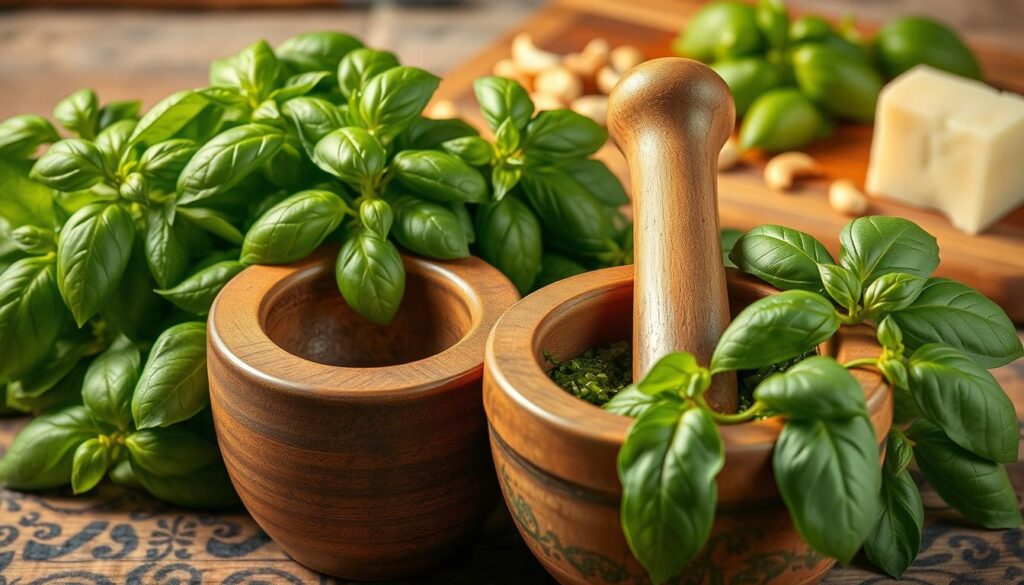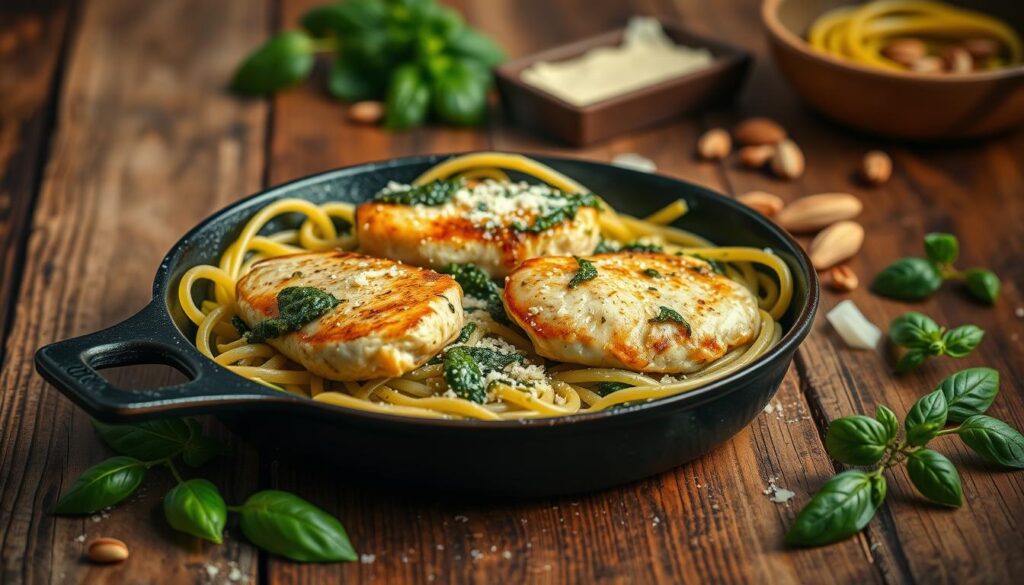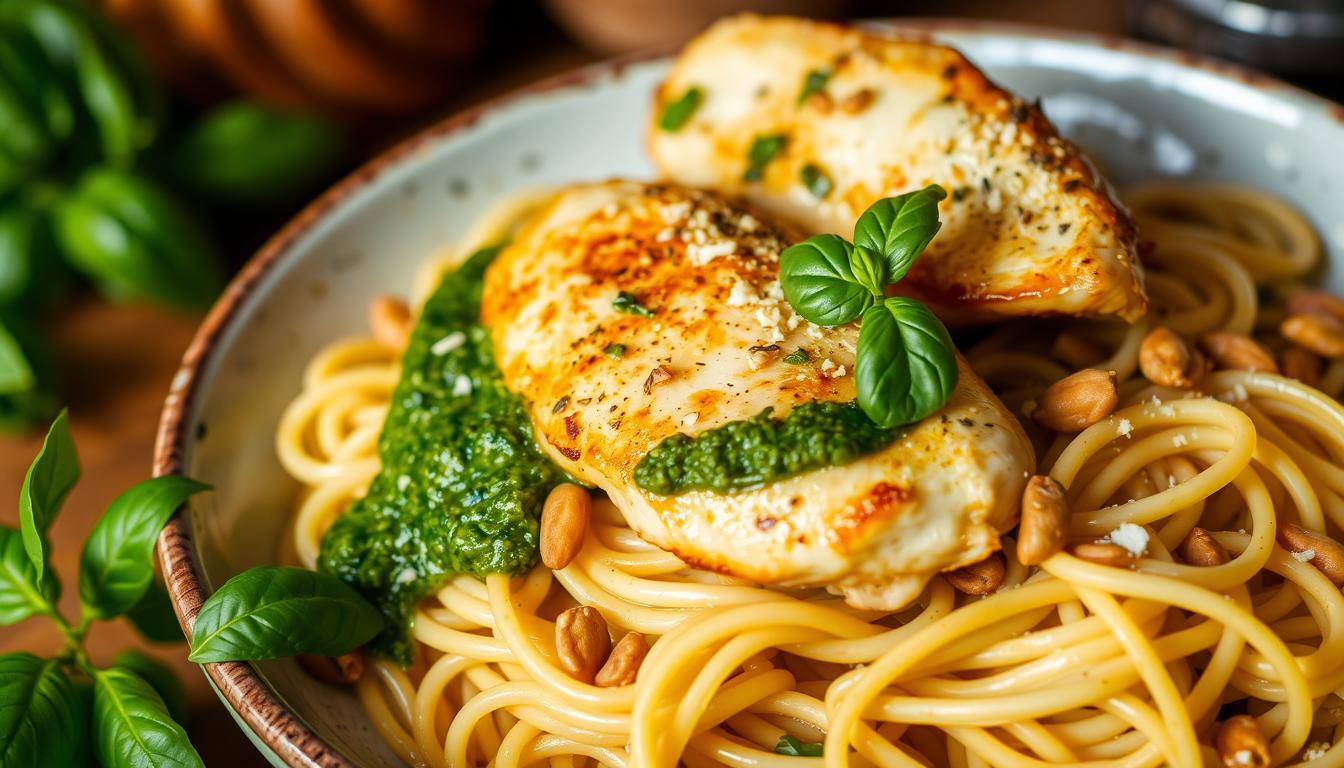Imagine walking into your kitchen and making a pesto chicken pasta recipe that wows your family. It’s a dream for every home cook to turn simple ingredients into something amazing. A homemade pesto pasta is more than a meal; it’s a way to enjoy Italian flavors in your own home.
This pesto chicken pasta recipe is perfect for a quick and tasty dinner. It’s easy to make and looks great, making it perfect for busy nights or special meals. Whether you’re a pro in the kitchen or just starting out, this recipe is sure to be a hit.
Key Takeaways
- Create a restaurant-quality meal in your home kitchen
- Master an easy and delicious pesto chicken pasta recipe
- Learn professional cooking techniques for perfect pasta
- Discover how to make authentic homemade pesto pasta
- Transform simple ingredients into an impressive dinner
Essential Ingredients for Pesto Chicken Pasta
Making a tasty pesto chicken pasta starts with picking the right ingredients. Your dish’s success depends on using top-quality items. These elements will make your pasta dish stand out.
Fresh vs Store-Bought Pesto Options
You can choose between homemade or store-bought pesto. Homemade pesto is fresher and lets you control the taste. It’s made with fresh basil, pine nuts, garlic, olive oil, and Parmesan cheese.
- Store-bought pesto is convenient
- Homemade pesto tastes better
- Quality ingredients matter
Choosing the Right Pasta Shape
The pasta shape is key to a great dish. Some shapes hold sauce better than others. Here are some good choices for pesto chicken pasta:
- Fusilli – spirals that trap sauce well
- Penne – tube shapes that hold pesto nicely
- Farfalle – bow-tie pasta with good sauce adherence
Best Cuts of Chicken to Use
Choosing the right chicken is important for flavor and tenderness. Boneless skinless chicken breast is a popular choice. Cut the chicken into even pieces for even cooking and flavor.
| Chicken Cut | Cooking Time | Flavor Profile |
|---|---|---|
| Chicken Breast | 10-12 minutes | Lean and mild |
| Chicken Thighs | 12-15 minutes | Rich and juicy |
Remember, always cook chicken to 165°F for safety. Your pesto chicken pasta is almost ready!
Kitchen Equipment and Tools Needed
To make tasty pesto chicken pasta, you need some key tools and essentials. Before you begin, make sure your kitchen has the right gear. This will make cooking smooth and fun.
Having the right tools is crucial for a great pasta dish. The right tools can greatly improve your cooking and the dish’s taste.
- Large cooking pot for pasta
- Non-stick skillet for chicken
- Sharp chef’s knife
- Cutting board
- Wooden spoon or spatula
- Tongs for handling chicken
- Colander for draining pasta
Professional chefs say quality kitchen tools are worth the investment. They last longer and cook better. Stainless steel or cast-iron cookware is best for even heat.
| Tool Category | Recommended Item | Purpose |
|---|---|---|
| Cookware | 12-inch non-stick skillet | Even cooking of chicken |
| Cutting Tools | 8-inch chef’s knife | Precise ingredient preparation |
| Pasta Tools | Large stock pot | Boiling pasta perfectly |
Pro tip: The right pasta tools can make your home cooking amazing. Choose versatile, high-quality tools for many recipes.
Preparing the Perfect Chicken for Your Pasta
Creating delicious pesto chicken pasta starts with preparing the chicken just right. The key to mouthwatering chicken lies in mastering chicken seasoning and cooking techniques that lock in flavor and moisture.
Your chicken preparation can make or break the entire dish. Proper seasoning is crucial for developing rich flavors that complement the pesto sauce.
Seasoning Techniques for Maximum Flavor
When it comes to cooking chicken, seasoning is your secret weapon. Follow these essential tips:
- Pat the chicken dry before seasoning to ensure crisp edges
- Use a blend of salt, black pepper, and garlic powder
- Consider a light dusting of flour for a golden, crispy exterior
- Allow seasonings to sit for 10-15 minutes before cooking
Mastering Cooking Temperature
Achieving juicy chicken requires careful temperature control. Use a medium-high heat setting to create a beautiful sear while keeping the inside tender.
- Heat your skillet until it’s hot but not smoking
- Add a touch of olive oil
- Cook chicken for 2-3 minutes per side
- Check internal temperature reaches 165°F
Ensuring Juicy Chicken Every Time
The secret to juicy chicken is avoiding overcooking. Pro tip: Let the chicken rest for 3-5 minutes after cooking to redistribute internal moisture. This technique guarantees tender, flavorful meat that will elevate your pesto chicken pasta from good to extraordinary.
Making Homemade Basil Pesto from Scratch

Making your own pesto is simpler than you might think. The secret to a great homemade pesto is its simple yet vibrant ingredients. Your kitchen will turn into an Italian culinary paradise with just a few ingredients.
To make a real basil pesto, you’ll need these key ingredients:
- 2 cups fresh basil leaves
- 1/2 cup extra virgin olive oil
- 1/3 cup pine nuts
- 2 garlic cloves
- 1/2 cup freshly grated Parmesan cheese
- Salt and pepper to taste
You have two main ways to make your pesto. The traditional method uses a mortar and pestle. This method releases the herbs’ oils and gives a rustic texture. On the other hand, a food processor is quicker and gives consistent results.
For the best basil pesto, use fresh basil and high-quality olive oil. Toast your pine nuts lightly before blending to bring out their nutty taste. Add cheese last to avoid over-mixing.
“The secret to great pesto is using the freshest ingredients and not overthinking the process.” – Italian Cooking Wisdom
Try adding your own twist to your homemade pesto. Some chefs add parsley or use walnuts instead of pine nuts for different flavors.
Creating the Creamy Pesto Sauce
To make a creamy pesto sauce, you need a few special steps. Mix the bright flavors of pesto with creamy goodness. This makes a sauce that sticks well to your pasta.
Start with top-notch ingredients for your creamy pesto sauce. Chefs say the right mix can turn a simple dish into a masterpiece.
Mastering the Cream and Pesto Blend
Here’s how to make a top-notch creamy pesto sauce:
- Begin with great pesto, store-bought or homemade
- Choose heavy cream for the creamiest texture
- Warm the mix gently to avoid separation
- Keep stirring until it’s smooth
Perfecting Sauce Consistency
Getting the sauce just right takes time and skill. Slow and steady wins the race when mixing cream and pesto. If it’s too thick, add some pasta water. Too thin? Simmer it a bit to thicken.
Enhancing Flavor with Parmesan
“The secret to an incredible sauce is in the details” – Culinary Wisdom
Grated Parmesan cheese adds flavor and thickens your sauce. Add it slowly, letting it melt. This makes your pasta taste amazing.
- Use freshly grated Parmesan for the best taste
- Add cheese off the heat to avoid graininess
- Adjust salt and pepper to your liking
Step-by-Step Pesto Chicken Pasta Assembly

Making a great pesto pasta recipe needs focus on the final steps. Your dish will look and taste amazing with these steps.
- Drain your pasta, saving about ½ cup of pasta water for sauce adjustment
- Put the cooked pasta back in the warm pot
- Add your creamy pesto sauce to the pasta
- Mix in the cooked chicken gently
For a top-notch pesto chicken pasta, aim for a smooth sauce. If the sauce is too thick, use pasta water to thin it. Stir carefully to avoid breaking pasta or shredding chicken.
“The magic happens when all ingredients are harmoniously combined” – Professional Chef’s Tip
Strive for a sauce that coats every pasta strand and chicken piece. You want a creamy, tasty dish that’s also visually appealing.
| Technique | Purpose |
|---|---|
| Gentle Folding | Prevents pasta breakage |
| Pasta Water Usage | Adjusts sauce consistency |
| Warm Pot Method | Keeps sauce temperature ideal |
Serve right away for the best taste and texture of your homemade pesto chicken pasta.
Tips for Perfect Pasta Cooking
Learning how to cook pasta can make your dishes go from good to great. The key is to cook the pasta just right. This ensures it has the perfect texture and taste.
Cooking pasta might seem easy, but getting it just right is tricky. “Al dente” pasta is what you want. It’s tender but still has a bit of bite.
Water Salting Techniques
Salting the pasta water is important for flavor. Here’s what the pros say:
- Use 1-2 tablespoons of kosher salt per quart of water
- Salt the water before adding pasta
- The water should taste like sea water
Al Dente Pasta Cooking Secrets
To get al dente pasta, timing and technique are key. Here are some tips from the experts:
| Pasta Type | Cooking Time | Al Dente Check |
|---|---|---|
| Spaghetti | 8-10 minutes | Slightly firm center |
| Penne | 10-12 minutes | White dot in center |
| Farfalle | 9-11 minutes | Slight resistance when bitten |
“Pasta cooking is an art that requires patience and practice.” – Italian Culinary Master
Always taste your pasta 1-2 minutes before it’s done. You want a perfectly balanced texture that goes well with your pesto chicken sauce.
Vegetable Add-ins and Variations
Adding vegetables to your pesto chicken pasta can make it more exciting and healthy. These additions bring flavor and nutrients, making your dish more vibrant and tasty.
Here are some tasty vegetable options for your pesto pasta:
- Roasted Asparagus: Adds a crisp texture and earthy flavor
- Sweet Cherry Tomatoes: Brings bright, fresh bursts of flavor
- Sautéed Spinach: Introduces rich green color and iron content
- Grilled Zucchini: Provides a smoky, tender complement
- Caramelized Bell Peppers: Delivers a sweet, robust taste
Each vegetable can be prepared in different ways to enhance its taste. Roasting brings out deeper flavors, while quick sautéing keeps them crisp. You can also add raw vegetables for a fresh crunch or cook them to blend with the pesto.
“Creativity in the kitchen begins with experimenting with different ingredients!” – Chef Marco Rossi
Remember, choose vegetables that are in season for the best taste and freshness in your pesto chicken pasta.
Proper Storage and Reheating Methods
Storing pasta dishes right keeps the flavors of your pesto chicken pasta fresh. If you’ve made too much or want to save leftovers, storing them correctly is crucial. It helps keep the quality and taste of your dish.
Here are the key steps for storing pasta:
- Store your pesto chicken pasta in an airtight container
- Refrigerate within 2 hours of cooking
- Keep in the refrigerator for 3-4 days maximum
Reheating pasta needs care to keep its texture and taste. When reheating, try these methods:
- Use a microwave-safe dish with a splash of water or cream
- Heat in 30-second intervals, stirring between each
- Add a small amount of fresh pesto to revive the sauce
Pro tip: For the best results, avoid reheating pasta multiple times. Reheat only the portion you plan to eat immediately.
Freezing is another way to keep your dish longer. Wrap the pasta tightly in freezer-safe containers, removing as much air as possible. Frozen pesto chicken pasta can last up to 2 months when stored right.
Conclusion
Making homemade pesto chicken pasta is simpler than you think. With the right ingredients and a bit of passion, you can turn a weeknight dinner into a special meal. This recipe lets you add your own twist, making it unique every time.
This dish is all about being flexible. Try different pasta shapes, use other proteins, or add your favorite veggies. It’s perfect for family dinners or when you have friends over. Your pesto chicken pasta will always be a hit.
Don’t be afraid to get creative in the kitchen. Share your cooking stories and new ideas on social media. Every time you make this dish, you’ll get better and find new flavors to love.
Great cooking is about enjoying the journey and making memories. Your pesto chicken pasta is more than food. It’s a way to bring people together, one delicious bite at a time.


6 thoughts on “How to Make the Perfect Pesto Chicken Pasta at Home”